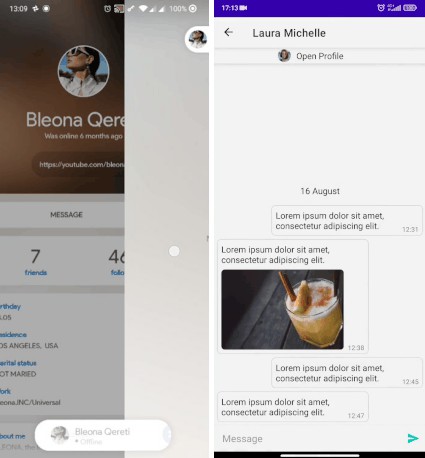Fragula: A swipe-to-dismiss extension for navigation component library for Android

Fragula 2
Fragula is a swipe-to-dismiss extension for navigation component library for Android. It is an adaptation of an earlier version created by @shikleev and now maintained in this repository.
Table of Contents
Gradle Dependency
Add this to your module’s build.gradle file:
dependencies {
...
implementation 'com.fragula2:fragula-core:2.0-rc02'
}
The fragula-core module contains everything you need to get started with the library. It contains all core and normal-use functionality.
The Basics
First, you need to replace NavHostFragment with FragulaNavHostFragment in your layout:
<!-- activity_main.xml -->
<androidx.fragment.app.FragmentContainerView
xmlns:android="http://schemas.android.com/apk/res/android"
xmlns:app="http://schemas.android.com/apk/res-auto"
android:layout_width="match_parent"
android:layout_height="match_parent"
android:name="com.fragula2.FragulaNavHostFragment"
android:id="@+id/nav_host"
app:navGraph="@navigation/nav_graph"
app:defaultNavHost="true" />
Second, you need to replace your <fragment> destinations in graph with <swipeable> as shown below:
<!-- nav_graph.xml -->
<navigation xmlns:android="http://schemas.android.com/apk/res/android"
xmlns:app="http://schemas.android.com/apk/res-auto"
xmlns:tools="http://schemas.android.com/tools"
android:id="@+id/nav_graph"
app:startDestination="@id/detailFragment">
<swipeable
android:id="@+id/detailFragment"
android:name="com.example.fragula.DetailFragment"
android:label="DetailFragment"
tools:layout="@layout/fragment_detail" />
...
</navigation>
Finally, you need to set opaque background to your fragment’s root layout to avoid any issues with swipe animation.
<!-- fragment_detail.xml -->
<androidx.constraintlayout.widget.ConstraintLayout
xmlns:android="http://schemas.android.com/apk/res/android"
android:layout_width="match_parent"
android:layout_height="match_parent"
android:background="?android:colorBackground">
...
</androidx.constraintlayout.widget.ConstraintLayout>
Now if you open the app you’ll see that you can swipe fragments like in Telegram, Slack and many other messaging apps.
More Options
Destination Arguments
In general, you should work with Fragula as if you would work with normal fragments. You should strongly prefer passing only the minimal amount of data between destinations, as the total space for all saved states is limited on Android.
If you need to pass large amounts of data, consider using a ViewModel.
First, add an argument to the destination:
<swipeable
android:id="@+id/detailFragment"
android:name="com.example.fragula.DetailFragment">
<argument
android:name="itemId"
app:argType="string" />
</swipeable>
Second, create a Bundle object and pass it to the destination using navigate() as shown below:
val bundle = bundleOf("itemId" to "123")
findNavController().navigate(R.id.detailFragment, bundle)
Finally, in your receiving destination’s code, use the getArguments method to retrieve the Bundle and use its contents:
val textView = view.findViewById<TextView>(R.id.textViewItemId)
textView.text = arguments?.getString("itemId")
It’s strongly recommended to use Safe Args plugin for navigating and passing data, because it ensures type-safety.
Page Transitions
You may want to know when the scrolling offset changes to make smooth transitions inside your fragment view.
To start listening scroll events you need to retrieve SwipeController and set OnSwipeListener as shown below:
Note: Currently shared element transitions between destinations is not supported in any form.
class DetailFragment : Fragment(R.layout.fragment_detail) {
private lateinit var swipeController: SwipeController
private lateinit var listener: OnSwipeListener
override fun onViewCreated(view: View, savedInstanceState: Bundle?) {
super.onViewCreated(view, savedInstanceState)
...
swipeController = findSwipeController() // retrieve SwipeController for a fragment
listener = OnSwipeListener { position, positionOffset, positionOffsetPixels ->
// do something with values
}
swipeController.addOnSwipeListener(listener)
}
override fun onDestroyView() {
super.onDestroyView()
swipeController.removeOnSwipeListener(listener)
}
}
Remember: you must remove the listener when the fragment view is destroyed.
Multiple BackStacks
Currently multiple backstacks is not supported, which means you can’t safely use extensions such as
NavigationView.setupWithNavController(...) and BottomNavigationView.setupWithNavController(...)
without losing your current backstack.
Theming
In most of the cases there is no need to change any of these values, but if you really need to you can override these attributes in your activity theme.
<style name="AppTheme" parent="Theme.MaterialComponents.Light.NoActionBar">
<item name="colorPrimary">...</item>
<item name="colorPrimaryDark">...</item>
<item name="colorAccent">...</item>
<!--
This overrides the color used for the dimming when fragment is being dragged.
The default value is #323232 for both light and dark themes.
-->
<item name="fgl_dim_color">#323232</item>
<!--
This overrides the amount of dimming when fragment is being dragged.
Think of it as a `fgl_dim_color` alpha multiplier.
-->
<item name="fgl_dim_amount">0.2</item>
<!--
This overrides the duration of swipe animation using `navController.navigate(...)`
and `navController.popBackStack()` methods.
-->
<item name="fgl_anim_duration">300</item>
</style>